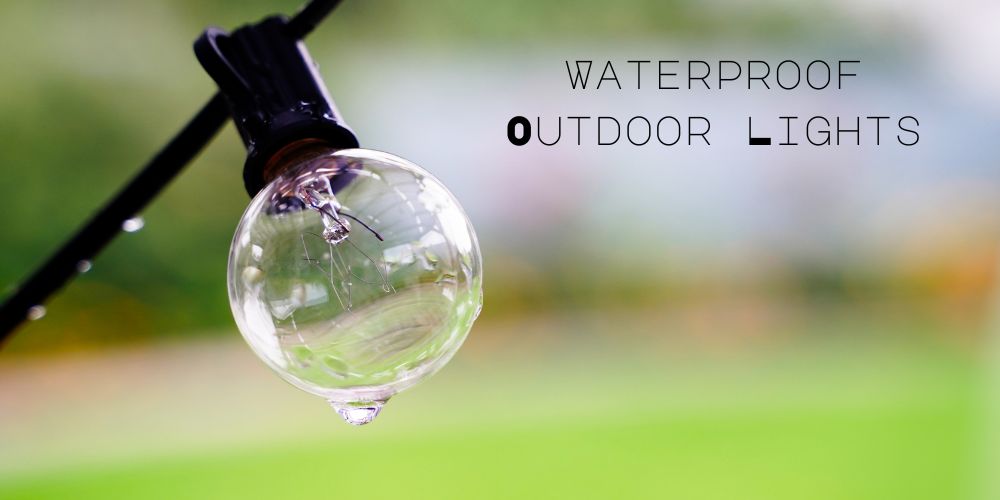Texas backyards see everything from bone-dry summers to cloudbursts that drop three months of rain in one day, like the 9-inch downpour Huntsville recorded on May 2, 2024. In Houston, annual rainfall averages more than 50 inches, and severe storms can roll in with tropical-storm winds or late-spring hail.
Those swings make outdoor lighting in Texas a job for fixtures that shrug off water, dust, and high humidity, otherwise known as waterproof outdoor lights.
Why Waterproof Outdoor Lights Matter?
Outdoor wiring and moisture never mix. Without the correct IP (Ingress Protection) rating, fixtures can corrode, short-circuit, or become shock hazards. A waterproof rating of IP65 blocks dust and low-pressure jets of rain, while IP67/68 gear can handle short-term submersion—ideal near pools and fountains.
Using the right rating keeps landscape lighting systems safe and extends bulb life well past the warranty.
Situations That Call for Waterproof Lights
| Scenario | Why Waterproof? | Suggested IP Rating |
|---|---|---|
| Water features – pools, koi ponds, fountains | Direct splashes or full immersion | IP67–IP68 |
| Exposed landscapes – garden paths, lawn edging, driveways | Hit by storm runoff and sprinklers | IP65–IP66 |
| Patios & decks | Wind-blown rain reaches fixtures under eaves | IP65 |
| Coastal or high-humidity areas | Salt air and condensation accelerate rust | IP66+ with corrosion-resistant housing |
| Spring storms & hurricane season | Heavy rain, wind-driven debris, flooding | IP66–IP67 plus sealed connectors |
Benefits You’ll Notice
- Safety: Weatherproof lights cut the risk of shocks because seals keep wiring dry.
- Longevity: Gaskets and powder-coated housings fight rust, so LEDs last their full 50,000-hour span even in Houston’s humidity.
- Aesthetics: Consistent performance means no dark corners after the first thunderstorm. As Houston Lightscapes notes, durable fixtures keep patios inviting “rain or shine.”
- Reduced maintenance: Less frequent replacements and fewer service call-backs.
Types of Weatherproof Outdoor Lights
- Path & Bollard Lights (IP65): Sturdy aluminum posts rated to resist garden hose spray—perfect for outside home lighting along walkways.
- Wall Sconces (IP66): Great for exterior house lighting beside garage doors; water jets from gusty storms won’t penetrate.
- Submersible Pond Spots (IP68): Fully sealed, often stainless steel. Aim them at waterfalls for dramatic night views.
- LED Strip or Tape (IP65 coating): Flexible accents under deck rails or outdoor kitchens; the silicone jacket blocks rain.
- Low-Voltage transformers outdoor lighting (IP65 enclosures): Brands such as Leonlite include molded gaskets and overload breakers so the power supply keeps running during downpours.
Choosing the Right Rating
- IP44: suitable for well-covered porches but shouldn’t be used where it will be exposed directly to rain.
- IP65: minimum for Texas yards—handles dust and heavy rain from any direction.
- IP66: adds protection from high-pressure jets—important if you pressure-wash the driveway.
- IP67: survives brief flooding; use in low spots that puddle.
- IP68: built for permanent underwater placement.
Experts recommend IP66 or higher for anything at ground level and IP68 for pool niches.
Best Times and Places to Install
1. New Pool or Spa
Pool codes already require low-voltage circuits; pairing them with IP68 niche lights and an IP65 transformer prevents nuisance trips and algae-dark corners.
2. Rainy-Season Retrofits (March–June, again in September)
Upgrading now lets fixtures prove themselves during peak thunderstorm months when rainfall can double normal totals along the Gulf Coast.
3. Patio Makeovers
String or rope lights with IP65-rated covers can handle the sideways rain typical of summer storms and continue working even when the weather turns.
4. Hill-Country Xeriscapes
Rock gardens shed water fast yet collect dust. IP65 spike spots keep LED drivers clean while highlighting agaves after dark.
5. Coastal Installations
Salt spray speeds up corrosion along the coast from Galveston to Port Aransas. Look for fixtures labeled “marine-grade” plus IP66 gaskets to ensure weatherproof lights stand up to sea air.
Practical Tips for Texas Homeowners
- Seal every connection: Moisture sneaks into tiny gaps and can corrode copper overnight. After you twist conductors together, slide on a gel-filled wire nut or crimp a heat-shrink butt connector. The built-in sealant fills air pockets, and the heat-shrunk sleeve locks out rain, sprinkler spray, and soil vapor—so no splice becomes the weak link that shorts an entire lighting run.
- Elevate the transformer: Low-voltage transformers are built to shed water from above, not from below. Mount the unit on a masonry wall, metal post, or treated-wood backboard at least 12 inches above grade. Even during a flash-flood warning, standing water can’t reach the enclosure or the GFCI receptacle. Keep plants and mulch trimmed back three inches on all sides to maintain airflow and make inspections easy.
- Manage voltage drop: Light levels fade when wire runs stretch a long distance. If the path from the transformer to the farthest fixture tops 100 feet, step up the conductor size to 10- or 12-gauge and choose a multi-tap waterproof transformer with 12-, 13-, 14-, and 15-volt output options. Start the longest circuit on the higher tap, measure with a multimeter at the last fixture, and aim for 10.5–11.5 volts under load. Balanced voltage keeps LEDs bright and color-consistent across the whole yard.
- Prepare for hurricanes: Gulf Coast winds treat loose hardware like a wrench. Swap zinc screws for 316-grade stainless steel or hot-dipped galvanized fasteners that resist salt spray and high humidity. Secure path-light stakes with landscape adhesive if the soil is sandy. Keep one spare photocell and a packet of waterproof quick-connects in your garage; falling branches often break sensors first. After any major storm, shut off the circuit, walk the property, and tighten or replace damaged parts before you power back up.
Why Call Tree Amigos Tree Service?
For two decades, our certified arborists have wired landscape lighting Houston homeowners can rely on—tying lighting runs neatly to root-safe trenches, sizing conductors for Texas heat, and specifying fixtures that meet or exceed IP65. We coordinate with irrigation techs so spray patterns never aim straight at fixtures, and we service the entire San Antonio–Houston corridor.
Upgrade your landscape with durable outdoor lighting. Contact Tree Amigos Tree Service for expert waterproof lighting solutions!




